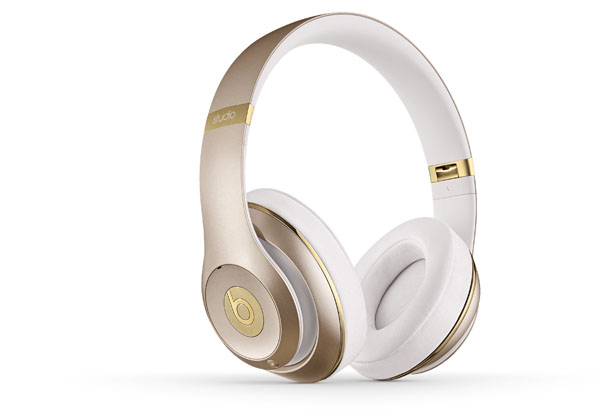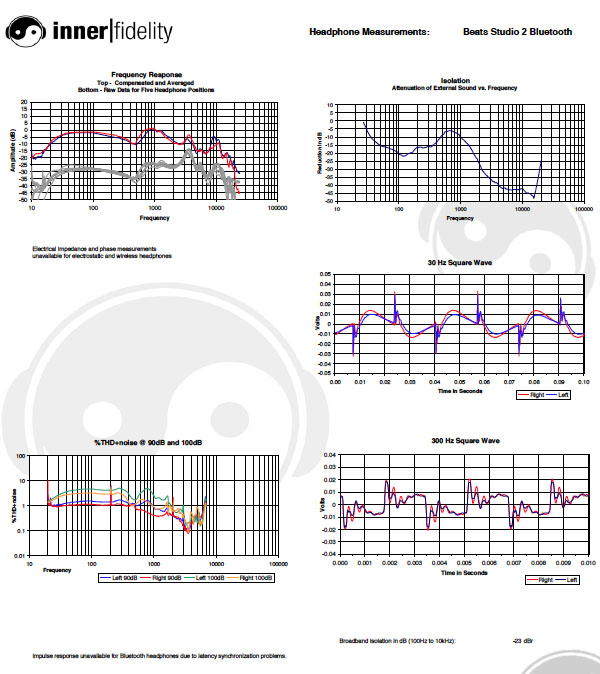| Columns Retired Columns & Blogs |
Bluetooth Headphone/Headset Survey Review - Beats Studio2 Wireless

Beats Studio Wireless ($349)
The recent Beats refresh of their headphone products has been welcome in sight and sound. The product line over-all has dramatically improved the build quality, styling, and sound quality of Beats products.
The new Studio and Studio Wireless are very good looking headphones, available in many colors, and solidly built. Earpads apear to be of very good quality protein leather over memory foam, and are quite comfortable. Headphone adjustability, folding mechanisms, accessories are all top notch.
The Beats Studio Wireless can be operated wired with the included cable, and is also a noise canceling headphone. Unfortunately, the noise canceling can not be turned off, and will not run wired when the battery dies.
Sound quality is somewhat improved over the original Studio, but it isn't as significant as improvements I've heard in other models of the line like the Solo2 (reviewed here). Surprisingly, given Beats penchant for elevated bass response, the new Studio and Studio Wireless (which sound very similar) tend to lack a little bass weight. It's not that they sound thin or bright, just a general mild lack of body. In isolation, the bass response is decent among this group of cans with good extension and transition into the mids, but dynamics are a hampered by a mildly loose sound and it's slightly lower level than ideal.
Mid-range is a problematic with the Studio. It's easiest just to point at the FR plot below where you'll see the Studio looking pretty good until it gets to 500Hz where it jumps up in level rising 10dB in one octave (500Hz to 1kHz). This discontinuity through the mid-range, it seems to me, is causing the low-mids to have less weight than the high-mids and produces vocals that lack the heft of a real voice.
Treble response is nicely balanced with the upper-mid response, but tends to add some "zazz" around cymbals and snares making them a bit more emphatic and less clear.
If these didn't have that discontinuity dead smack in the middle of the mid-range they'd be pretty good sounding, but I think most consumers will get used to these headphones pretty quickly and be fairly satisfied. If it weren't for the next issue I'm about to bring up, I might have even given the Beats Studio a mild recommendation to folks set on buying into the Beats brand. Bassheads, though, will be quickly disappointed.
And now for the Achilles heel: The noise canceling in these headphones is acoustically unstable and on the verge of low-frequency oscillation. This condition worsens when the headphones are obstructed on the outside. For example, in the winter when I have on layers of coats, if the collar of my wooly sweater starts to cover the Studios they begin to go into this oscillation—it sounds like "whomp-whomp-whomp-whomp" at about a 3Hz rate.
Another example is if I'm wearing them in bed on a soft pillow, as my head settles in and the pillow starts coming around to partly cover the earpieces of the headphone I'll begin to get the oscillation. Depending on how much the earpieces are covered it can go from mildly annoying to downright intolerable. Some time ago after I discovered this problem, I posted a poll asking how often people listened to headphones in bed. A full 50% of respondents selected either "most every night" or "a few times a week". I wanted to know if this oscillation was really a problem or not, and with 50% of people regularly using headphones in bed, I've come to the conclusion that this problem is a deal killer for the Studio.
At $349, with just average sound quality, and being unusable in bed, I can't possibly recommend the Beats Studio (yep, it has the problem, too) or Beats Studio Wireless. Bummer, they've done so much to improve their product, but kind of blew it on their flagship.
Click on graphs image to download .pdf for closer inspection.
As I mentioned above the big problem with the Studio and Studio Wireless is the significant discontinuity in FR at 500Hz. If the whole top part of the response 1kHz and up were shifted down 5-8dB these would be much better sounding headphones.
You'll also notice between 10Hz and 20Hz on the uncompensated FR plots (in gray) some weird, spurious results. This originates from the headphone being so close to acoustic instabilities that when fed very low frequency signals it tries to set off the low frequency oscillations.
Even though the low-frequency response between 30Hz and 300Hz is fairly linear, the 30Hz square wave shows extremely sway back waveform shape. This usually indicates a significant swinging of phase response, and will generally result in less impact and punch down low.
300Hz square wave show significant ringing after the initial transient, which usually indicates the treble will have some artificial sounding characteristic. I did hear extra information around cymbals and snares that gave them some extra zazz, but I wouldn't characterize this problem terribly bothersome.
THD+noise plots here are awful odd looking, and this might in part be due to the BT transmitter. However, after looking through all the data sheets in this wireless group, I don't see any others where the 100dB line is above the 90dB line over so much of its response, which indicates these may have poor power handling ability. Probably not a good can for loud listening.
Isolation is okay for a noise canceler at -23dB broadband. But much better can be had with the Zik 2.0, for example.
- Log in or register to post comments





































